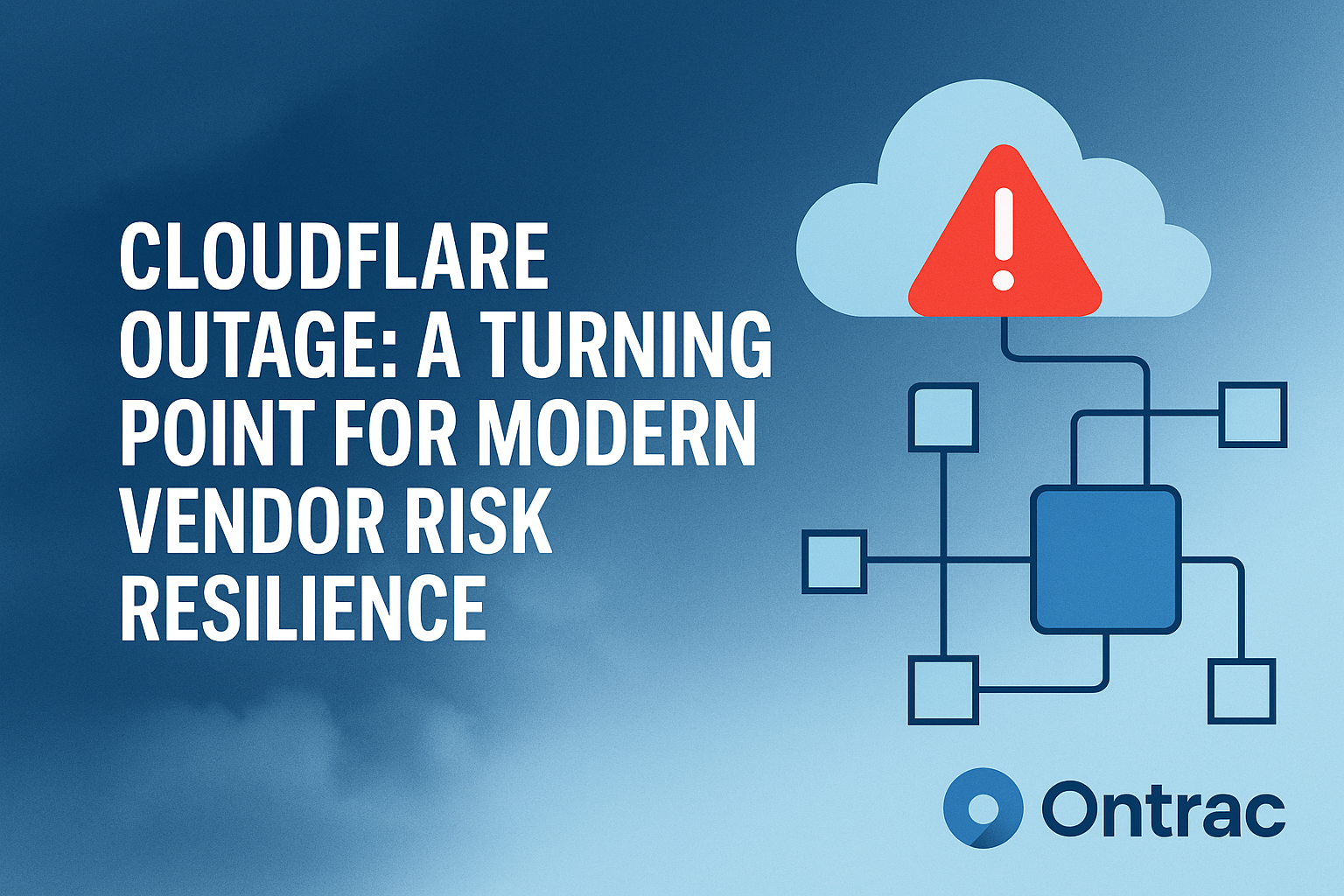Cloudflare’s November 18, 2025 Outage: A Turning Point for Modern Vendor Risk Management
Read Time 6 mins | Written by: Eric Fouarge

When Cloudflare experienced a widespread outage on November 18, 2025, the ripple effects were immediate and global. Businesses across industries lost access to critical applications, customer experiences stalled, and operations slowed to a crawl — all because a single point of dependency fractured.
For leaders navigating today’s cloud-driven world, this wasn’t just another incident. It was a wake-up call that exposed the fragility of our interconnected digital ecosystems and the urgent need for stronger, more proactive vendor risk strategies.
At Ontrac Solutions, we view events like this as moments for organizations to re-evaluate how they design, scale, and govern their cloud footprint — and how they protect themselves when the unexpected hits.
I. What Happened — and Why It Matters
The outage stemmed from an internal Cloudflare deployment that cascaded across global infrastructure, disrupting DNS, CDN, edge services, and application delivery. Because Cloudflare sits in front of such a large portion of the web, the blast radius was massive.
For enterprises relying heavily on Cloudflare as a front-door dependency, it underscored three truths:
- Your cloud is only as resilient as your weakest vendor.
- Modern digital operations depend on a complex web of sub-vendors, service chains, and third-party integrations.
- Vendor risk management can no longer be a compliance checklist — it must be an operational discipline.
This event didn’t just affect Cloudflare customers. It shook confidence in the broader architecture patterns many organizations use today.
II. The Hidden Layers of Vendor Dependency
Today’s cloud environments are built on multi-layered external services: CDNs, DNS providers, identity platforms, observability tools, AI APIs, billing engines, and more. When one layer goes down, everything above it follows.
What the Cloudflare outage exposed:
- Most companies underestimate how many operational nodes exist between their product and their customer.
- Vendor interdependencies often sit deep in the stack, invisible to business stakeholders.
- Many organizations have no real-time visibility into sub-vendors or inherited risks.
- Even “best-in-class” vendors introduce operational fragility.
This is why robust TPRM (Third-Party Risk Management) is no longer optional. It's foundational to the modern cloud operating model.
III. The Regulatory Shift: Non-Negotiable Preparedness
Regulators around the world have been signaling this shift for years. Mandates like DORA, the EU Data Act, and emerging U.S. regulations are moving from advisory to enforcement.
The Cloudflare incident validated exactly why these rules exist — because digital resilience isn’t just an IT issue anymore. It’s a business continuity requirement.
Expect regulators to push harder on:
- Multi-vendor redundancy
- Exit strategies and portability
- Transparent sub-vendor disclosures
- Independent testing and scenario modeling
- Continuous monitoring, not point-in-time assessments
In short: the bar is rising, and companies need to rise with it.
IV. The New Standard for Vendor Risk Management
Leading organizations — especially PE-backed operators and enterprise IT leaders — are shifting from reactive governance to proactive operational resilience.
Modern vendor management now demands:
- Real-time observability across vendors and sub-vendors
- Continuous security and compliance monitoring
- Stress testing for failure scenarios
- Contract terms that actually protect the business
- Architectural patterns designed for graceful degradation
- Automated alerting, testing, and response workflows
The companies who treat vendor risk as a strategic capability are the ones who maintain trust and stability during moments of disruption.
V. Why Private Equity and Enterprise Leaders Are Reassessing Their Cloud Posture
The outage created a wave of board-level discussions across our clients. The questions were consistent:
- What single points of dependency put our portfolio at risk?
- How quickly can we fail over critical services?
- Do we have a true multi-cloud or multi-CDN posture — or just marketing material?
- Are we operationally ready for the next major outage?
- Are our vendors aligned with our security, uptime, and compliance expectations?
Cloud excellence isn’t measured by how well systems run on a normal day — but how well they recover on a bad one.
This is now a competitive differentiator.
VI. Where the Market Is Heading
The TPRM landscape is undergoing rapid transformation. Cloud-native vendor risk platforms are moving toward:
- AI-driven continuous monitoring
- Automated scoring and anomaly detection
- Behavior-based alerting
- Deep integration with cloud-native observability tools
- Holistic risk dashboards that bring security, reliability, and compliance together
The market is shifting from annual audits to always-on intelligence.
This is how the next generation of resilient enterprises will operate.
VII. A Practical Enterprise Action Plan
For organizations looking to fortify their cloud posture, Ontrac Solutions recommends seven foundational actions:
- Adopt a “Design for Failure” Mindset
Architect assuming outages will occur — and ensure critical paths have redundancy. - Diversify Critical Dependencies
Multi-cloud, multi-CDN, and multi-region designs reduce single-vendor reliance. - Deepen Vendor and Sub-Vendor Due Diligence
Look beyond SOC 2 reports; validate architecture, operational maturity, and failover capabilities. - Strengthen Contracts and SLAs
Ensure clear terms around uptime, incident response, data portability, and liability. - Implement Continuous Vendor Monitoring
Move from annual reviews to real-time threat and performance visibility. - Build a Risk-Aware Culture Across the Business
Cloud resilience is not solely an engineering function — it’s an organizational discipline. - Stay Ahead of Regulatory Expectations
Align programs now with the direction regulators are headed — not where they used to be.
Enterprises that operationalize these practices will navigate cloud disruptions with more confidence and less downtime.
VIII. Conclusion: Resilience Is Now a Strategy, Not a Safety Net
The Cloudflare outage was a reminder that even the strongest vendors have failure points. In a hyperconnected digital world, resilience isn't about preventing every disruption — it’s about building architectures, processes, and teams that can withstand them.
Organizations that embrace proactive TPRM, modern cloud design principles, and continuous monitoring will lead with stability, trust, and optionality.
At Ontrac, we help organizations modernize their cloud footprint, harden operational resiliency, and implement risk-aware strategies that withstand moments exactly like this.
Cloud resilience isn’t the future. It’s the requirement.
Supporting Links:
Cloudflare Outage & Internet Infrastructure
- Cloudflare System Status
https://www.cloudflarestatus.com/ - ThousandEyes Global Internet Outage Map
https://www.thousandeyes.com/outages
Vendor Dependency & Cloud Architecture
- AWS Well-Architected Framework (Resilience Pillars)
https://aws.amazon.com/architecture/well-architected/ - Netflix Chaos Engineering
https://netflixtechblog.com/tagged/chaos-engineering
Regulations & Digital Resilience
- Digital Operational Resilience Act (DORA)
https://finance.ec.europa.eu/publications/digital-operational-resilience-act-dora_en - CISA: Supply Chain & Vendor Risk Guidance
https://www.cisa.gov/resources-tools/resources/supply-chain-risk-management
Industry Insights & Strategy
- MIT Sloan Review — Resilience as Competitive Advantage
https://sloanreview.mit.edu/ - ServiceNow Vendor Risk Management Overview (Modern TPRM Capabilities) https://www.servicenow.com/products/vendor-risk-management.html
